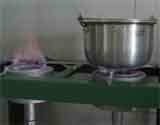TWO-BURNER RICE HUSK GAS STOVE FOR DOMESTIC OR INSTITUTIONAL COOKING OPERATION, Alexis Belonio, Appropriate Technology Center, Iloilo City, Philippines October 2005
 |
 |
 |

Our site is dedicated to helping people develop better stoves for cooking with biomass fuels in developing regions.
For additional detail and information, join the Cooking Stoves Mailing List, browse the archives, read about current projects and ask other cooking stove builders, designers, and organizations disseminating improved stoves around the world.
Copyright © 2006 - 2021 All Rights Reserved by the Original Contributor, Creator and Copyright holder.
Copyright is retained by the original contributor to the discussion list and web site.
Thanks to Alex English for the original (Crest/ REPP) biomass stoves site design.
Related Sites: Bioenergy, Gasification, Biochar (Terra Preta)
The BioEnergylists.org web sites, and related discussion groups are sponsored by:
TR Miles Technical Consultants Inc.
www.trmiles.com
Specializing in the Development of Biomass Energy and Environmental processes.